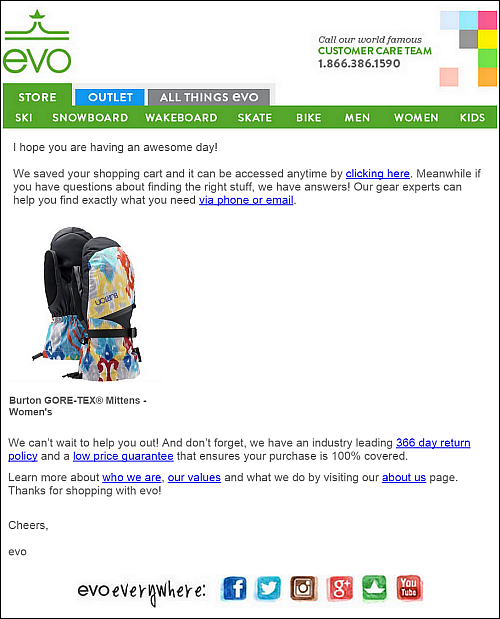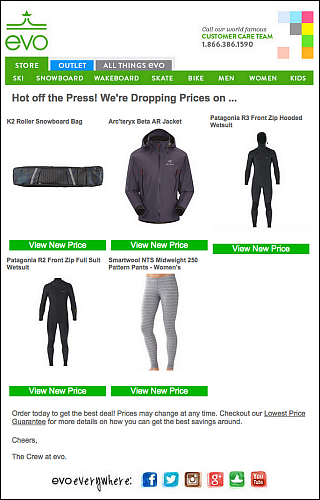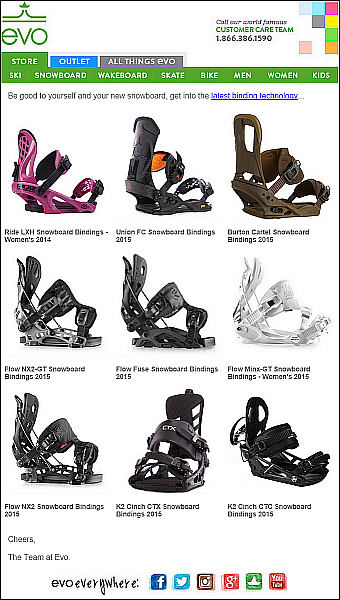by
Kayla Cobb, Reporter
THE CUSTOMER
evo, a leading online retailer of outdoor gear and fashion apparel based in the Pacific Northwest, primarily serves consumers who lead an active lifestyle. Because the company features equipment and apparel to fit skiing, snowboarding, wakeboarding, mountain biking, skateboarding and surfing communities, its consumer base is incredibly large.
"We shy away from the words 'action sports,' but that's probably most closely what it fits in — a mix between outdoor and action sports," Nathan Decker, Director of Ecommerce, evo, said.
Due to this large range of communities and interests, evo doesn’t target a specific demographic. According to Decker, the e-retail space's target customer tends to be more affluent, live in the urban mountains and be predominantly male, though that's trending in the other direction.
"We don't necessarily have a specific kind of archetype that we target," he added.
CHALLENGE
Over the past few years, evo had seen some deterioration when it came to its email sends. The e-retailer's clickthrough rates were not improving. In fact, they were getting worse and dragging open rates, engagement and revenue down with them.
"I think we had fallen into the fashion blasts trap, whereby we were just sending a lot of fairly blunt emails," Decker said. "We were targeting to some extent, but we were sending pretty broad promotions."
These blast emails worked for a while, but they quickly became noise in an already crowded inbox. evo's marketing team increased frequency occasionally over the years, but these raises in revenue were temporary.
"At some point we sort of wore out our voice, and our emails were becoming less and less relevant," he said.
evo saw a potential solution for this problem by becoming more automated and introducing triggered email sends. These sends would allow the company to send better and more relevant messages to customers.
CAMPAIGN
Tired of the low metrics on its sends, evo sought an emailing solution. After learning about the success other retailers had with cart abandonment and browse abandonment emails, evo's marketing team decided to try their hand at implementing these campaigns.
"We first attempted to make this happen using our email service provider," Decker explained. "It basically had to be a manual send that happened once a week … We were able to target people who had been to our cart [and] had not purchased and we sent them an email."
Though this approach did prove to be successful, the team was not getting the engagement rates or sales they were hoping for. They wanted to create messaging that was more targeted to their customers.
"It was at that point we stepped back, and we thought we needed to kind of revisit the technology we were using. The basic blocking and tackling wasn't going to do it. We were going to need something that was more robust, that had more advanced capabilities," he said.
Learn how changing the company's email technology to use one-to-one segmentation and implementing four different campaign series helped boost evo's clickthrough rate and increased revenue 20% compared to old email sends.
Step #1. Decide which campaigns to run
For this revamped email campaign, Decker and his team decided to first focus on implementing
cart abandonment and
browse abandonment sends.

Click here to see the full version of this creative sample
The decision to start with these two emailing options came from a brainstorming session with the team.
"They seemed like maybe the lowest hanging fruit, so that's what we targeted first," Decker said.
Browse abandonment occurs when someone visits a site but does not purchase a product or add anything to their cart. These addresses are captured when someone signs up, but they’re also obtained from evo’s non-triggered promotional campaigns. evo utilizes a snippet that will pick up customers who click through a promotional email and land on the company’s homepage.
"We made one tweak in our ESP, and we are handing over the email addresses to [our vendor]," he said.
Price drop series
Decker and his team also decided to implement a
price drop series. This series would email site visitors whenever an item they had previously viewed dropped in price. This applied to both cart abandoned and browse abandoned items.
Once the price drops on an abandoned item, an email is sent out with a subject line that reads something similar to, “Good News! We dropped the price on items just for you.” The email then includes an image of the product and a link at the bottom that reads, "View New Price." This send reconnects evo with the site visitor and potentially brings back abandoned customers who may have left because of price.

Click here to see the full version of this creative sample
"I'd say we're basing [our email sends] more on behavior," Decker said. "That's how we're segmenting within this program, as opposed to … demographics or something like that."
Step #2. Create templates and subject lines
Once the team decided which sends would be best for evo's audience, they started creating templates. A different template was created for each different send along with different subject lines. However, the team was sure to keep evo's brand standards in mind during the creation of these templates.
"We just adopted our typical email template, so there wasn't anything extra special about it," Decker said. "We wanted to be consistent with our other messaging that we send out."
When it came to subject lines, the team took a more dynamic approach. The subject line in the template was intentionally crafted to be as specific as possible. For example, if a customer added a Hyperlite Baseline Wakeboard to their cart before abandoning, that item's name would appear in their cart abandonment email.
"We wanted to call out the fact that we were highlighting something very specific [and] unique to that user," he said. "I think in the browse abandonment one, we actually call out the name of the product, the brand of the product, that the person is looking for."
The importance of feedback
On all of evo's sends, there is a
feedback link at the bottom of the email's footer, right above a link to the privacy agreement. This link leads to a "Contact Us" page on evo's site. The feedback goes directly to either Decker or one of the other evo employees who manages the emailing program.

Click here to see the full version of this creative sample
This small feature gives customers a direct line of communication when it came to evo's email sends but, for this campaign, it actually helped the company adjust its sends to reflect its customer’s preferences.
When this email series first launched, evo would only display products that the site visitor had actually looked at during their session. Based on the feedback the team received from customers, they soon learned that this approach was too targeted.
"Customers were sort of freaked out by that," Decker said. "A lot of them were saying things like, 'I know you're watching my browsing behavior. I know you're tracking me, but I don't want to see it. I don't want to see it in front of my face like that.'"
As a result of this negative feedback, the team started incorporating more recommended products.
"We backed off a little bit. Now, using our technology, we're able to insert related items as well," he said. "We show 60% of items they've seen and 40% of items that are going to be targeted and related to the items that they've seen."
Step #3. Set send frequency
With so many different sends in place, it was important to balance sends to not flood customers' inboxes. This was especially true because of the crossover in cart abandonment and browse abandonment.
"If somebody comes to your site and adds something to their cart every single day, do you want to email them every single day? Or, if they add something to their cart five times in a day, five different sessions, do you want to target them with five different emails? Probably not," Decker said.
The team limited the campaign to sending visitors one email a week. If a site visitor qualified for multiple triggers, they would still only receive one email.
Specifically when it came to cart and browse abandonment, there was also the question of how long the team should wait before sending an email. Too long after an abandoned cart or session and the customer could potentially forget about that the product they were viewing. Too soon after the abandonment had the potential of feeling invasive from the visitor’s point of view.
For cart abandonment, the team decided to set the first send to occur three hours after abandon. If no action is taken in 24 hours, a follow up email is sent. For browse abandonment, the email is scheduled to send four hours after the abandon.
The team emphasized the importance of creating a balance between being timely without being overbearing or greedy.
Step #4. Translate in-store experience to digital channel
After seeing the success of the abandonment sends, the team at evo decided to add one more send to this campaign:
a post-purchase series. Though this send did share the engagement and clickthrough goals of the other sends in the series, this email was specifically developed with a customer-centric focus in mind — to make evo’s digital experience as close as possible to its in-store experience.

Click here to see the full version of this creative sample
According to Decker, "At the end of the day, one of our main themes in all of our digital programming is to try to translate the experience you get in an evo store, of which we have two — one in Portland and one in Seattle."
"That's a huge bar," he added. "In the store, it's amazing the rich information you get when you're with one of our sales associates on the floor. They talk about items related to what you're buying. They talk about the experience that you're having. They're asking you questions about where you ski and how you ride."
This post-purchase series attempted to replicate the one-on-one attention found in-store.
For example, let’s say a customer buys a pair of ski boots. In the store, she would have a sales representative on hand to help her try on the boot, adjust the buckles and demonstrate all of the tricks that go into making sure a ski boot fits properly.
"Prior to [the post-purchase sends], we would send you a pair of ski boots and it was like, 'good luck,'" he said.
Enter the post-purchase series. This email series has three parts to it. The first send teaches customers how to try on their new ski boot and includes videos that walk customers through using their new product step-by-step.
This send has been especially beneficial to the team. Prior to this first send, evo was seeing returns because people didn’t know they had to make simple adjustments, such as taking the piece of paper out of the boot. This send was designed for customers who may not be as comfortable with the boot.
The second send focused primarily on teaching customers about their new boot.
According to Decker, "[The] second one is like, 'Okay, now you've had your ski boot for a few days. We're going to teach you some things you can do to customize the ski boot for your foot.'"
Finally, the third email is somewhat of a cross-sell, but it’s not intentioned to make the customer feel pressured to buy.
"If you're in our store buying a $350 pair of ski boots or $500 pair of ski boots, we're going to be like, 'What type of sock do you have? Because if you're wearing like a thick wool sock, or worse, anything cotton, don't buy that boot. You're just going to ruin your experience,'" he explained.
"That's the idea with these post-purchase series," Decker said. "It's recreating that physical experience digitally."
RESULTS
After launching these four email series, evo experienced a 20% increase in revenue when compared to its normal sends. evo also experienced an average 50-60% increase in clickthrough rate. This effort also led to higher open rates.
"Of the four that we talked about, open rates are really high among all of them," Decker said, adding that the rates are five times higher than typical promotional sends. "I think the highest is either the post-purchase or the window shopping."
The takeaway evo’s marketing team saw from this campaign was that a business needs to continue evolving, especially in the world of email.
"Email's a noisy world. Inboxes are crazy," he said. "If we can't find a way to be targeted and relevant to people, we're going to quickly fade into the background."
Sources
evoBluecore, evo's vendor
Creative Samples
- Cart abandonment send
- Browse abandonment send
- Price drop send
- Email feedback link
- Post-purchase series
Related Resources
Email Marketing: What do customers think of cart abandonment remarketing?Email Marketing: Cart abandonment campaign sees a 400% revenue boost over previous campaignEmail Marketing: First-time cart abandonment campaign drives a conversion rate 1,858% higher than weekly sendMarketing Automation: Triggered emails lift clickthrough 525% for BCBGMaxAzriaEmail Marketing Chart: How email influences purchases (online and off)













